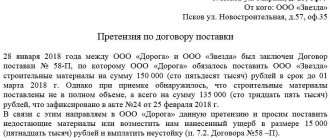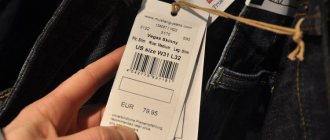Conditions for returning money for defective goods
In general, you have the right to demand a refund for any defective product. Although there are some exceptions to this rule that are important to consider.
For which product is the seller required by law to return the money after the fact, without disputes or obstacles:
- household goods that are designed for long-term use (for example, electric razors and toothbrushes, etc.);
- any interior items and home furnishings (beds, sofas, mirrors, etc.);
- sporting goods;
- Food;
- medicines and other medicines;
- personal hygiene products, etc.
There are also some categories of purchased goods for which it will be difficult to return money after the initial application. They require objective verification and substantial evidence that the item is damaged through no fault of the buyer. These are products that are technically complex:
- cars;
- snowmobiles;
- refrigerators and freezers;
- computers, laptops, system units;
- satellite and digital television;
- gaming consoles;
- photo and video cameras (digital) and others.
In other cases, it will be impossible in principle to return the money due to various reasons. For example, if it is difficult to clearly prove that the product was not damaged by you after purchase.
A product is considered damaged if it has defects. There are different categories of such defects, and they are the legal grounds for demanding a refund of funds paid:
- Factory defects. That is, the product does not meet GOST standards or other important technical requirements, and it is for this reason that the product is problematic (or impossible) to use.
- Defect in production. For example, significant external deviations and shortcomings.
- Violation of storage conditions. This often leads to damage to an initially high-quality product.
- Inaccurate transportation, which can also spoil the quality of the product.
- Natural causes of goods damage. For example, a flood in a warehouse led to the breakdown of phones, which were previously dried and still sold in the store and others.
Such defects may have already existed at the time of purchase or may have manifested themselves some time after purchase. Time in this case is not so important. The only thing that matters is the reason why the malfunction occurred. And if this is the fault of sellers, store consultants or the manufacturer, this is a direct basis for a refund.
Therefore, in some cases it will not be possible to get a refund for the product. We are talking about the following situations:
- the buyer carelessly handled the purchased item, and this is what caused its damage;
- the buyer did not store the item in the manner required by the product recommendations;
- the true cause of the appearance of defects was the actions of other people or the consequences of uncontrolled natural conditions - only after purchase;
- the seller pointed out defects during the purchase and discussed the terms with the buyer before paying for the goods;
- the buyer did not contact the seller immediately after discovering the defect and tried to repair the item himself, which led to a real deterioration in its properties, etc.
It happens that both parties are to blame for a product malfunction - both the consumer and the seller/manufacturer. There are no clear legal regulations for such a case, and the problem will have to be resolved personally with the seller. It is best to admit the equivalence of guilt and try to come to an agreement. What options are possible here:
- The seller or manufacturer agrees to fix the fault himself - but only that part for which he is responsible.
- A compromise solution - the seller will return only part of the money, which is agreed upon with the buyer.
What the law says about deadlines
In general, you should request a return during the warranty period. However, in some cases you can go beyond these limits, but you need to start from the conditions and nature of the damage.
If the defect is small (no major damage or defects, does not particularly affect operation, etc.):
- If the product did not have a warranty, then the acceptable handling time is two years from the date of purchase.
- If there was a warranty, then it is better to apply during its validity period. However, you have the right to demand a return later, but in this case you will need to prove that the presence of a defect is the fault of the seller or manufacturer.
If the defect is significant, the conditions are as follows:
- You have the right to request a return two years after purchase (or even after the warranty period has expired, if it was two years). It is important that the service life of the product at the time of purchase is current.
- If the service period is not established, then the maximum period during which your application will be valid is ten years.
In cases with significant damage or defects, there are special conditions that are also important to keep in mind:
- a dissatisfied buyer can only contact the manufacturer;
- it is the consumer who must prove the significance of the defect;
- You cannot immediately demand monetary compensation: at first it is legal to demand only free repairs;
- You can demand a refund only if the manufacturer does not correct the defect within twenty days.
For certain goods (food, household chemicals, medicines and perfumes) exceptional conditions are established:
- It is best to request a refund within the expiration date.
- If the deadline has expired, you need to prove that the product you purchased was of poor quality.
- If you bought a product when its expiration date had already expired, this is a direct violation of the law on the part of the seller, and you can demand money at any time.
- You can also demand a refund at any time if the product does not indicate an expiration date at all.
The deadlines for refunds for certain categories of goods are also defined:
- if a guarantee is established - from six months to a year;
- during the period when the expiration date is valid;
- if there is no indication of expiration date or warranty period, then within a reasonable period, but not longer than two years;
- if we are talking about seasonal goods - before the onset of the corresponding season.
All these circumstances are regulated by the Consumer Protection Law. It is the points of this document that will be the basis for both initial appeals to the seller or manufacturer, and for further ones if the issue cannot be resolved at this stage.
Sample letter for refund of advance payment from supplier
Let's consider a situation that can happen in practice (returning the advance).
GBOU DOD SDYUSSHOR "ALLUR" erroneously transferred an advance to LLC "Supply of goods" in the amount of 30,000 rubles. An agreement was concluded between the organizations for the purchase of sports balls for 100,000 rubles. Advance payments are not provided for under the contract. We are composing a letter.
Administrative return procedure: personal appeals and filing complaints and claims
So, you have taken into account all the conditions of the situation and are requesting a refund to the seller or manufacturer. Can you do it:
- orally during a personal visit;
- through written requests, complaints or claims.
In the first case, everything seems extremely clear, but it is better to take into account a couple of nuances:
- be sure to take all payment documents with you: checks, statements, etc.
- present the goods to the seller for personal inspection;
- do not allow the seller or manufacturer to take the goods before you receive your money.
A written form of appeal will be more effective when interacting with an unscrupulous seller or in controversial situations. First of all, this will be important evidence if you have to go to Rospotrebnadzor or the court.
Initially, you can apply for a refund for a defective product. It must be submitted to the seller or manufacturer. It should include:
- your data;
- seller details;
- Name of product;
- description and characteristics of the product;
- detailed description of the defect;
- an indication of satisfaction of the warranty period (or other conditions when recourse is possible after the expiration of this period);
- specific requirement to return funds.
The seller must sign this statement - even if he refuses to return the money.
If your request is granted, the seller will draw up a transfer and acceptance certificate, which will reflect the receipt of the defective product and a refund to the buyer.
If you cannot return the money in this manner, you can contact the claim form. It should be submitted in the name of the owner of the store where you purchased the goods - a legal entity or an individual.
What should such a claim contain:
- data – yours and the seller’s;
- Product name;
- its full description - appearance, technical characteristics, and so on;
- description of the purchasing process - according to the principle “on such and such a date the next product was purchased...”;
- your contacts;
- an indication that you previously contacted the seller and he refused to return (if this fact occurred);
- the period during which you are going to wait for the return;
- the specific requirement is to return funds in the specified amount.
The claim should be accompanied by evidence of your words: a sales receipt, an application for a refund for the seller, etc.
You should also reflect the seriousness of your intentions: if you do not get the money back, you will appeal to higher authorities or the court.
Then there are two possible scenarios:
- you will receive an answer: positive or negative;
- the answer to your complaint will be inaction.
If the manufacturer or store owner agrees to return your money, he will contact you at the specified contacts and inform you where and when you can get your money back.
In case of refusal or response silence, you can submit a written appeal again, but to other authorities - Rospotrebnadzor or the Society for the Protection of Consumer Rights.
What should reflect the content of requests to these organizations:
- your data;
- data of the store (its director, legal entity, seller, etc. - depending on the situation);
- a detailed description of the purchased product with a defect - external, technical;
- description of the situation - the moment of purchase, detection of damage or defects, contacting the seller and manufacturer, refusal or inaction in response;
- request to oblige the seller/manufacturer to return your money.
Attach all evidence of your position to the document: sales receipts, a claim or application for a refund, replies with refusal.
Once your application has been reviewed, you will be contacted (by phone, email, or via notification to your address) and informed of its decision.
If your request is granted, the seller will be obliged to return the funds to you within a specific period.
If at this stage you receive a refusal, but still do not agree with it, you can only go to court further.
What to do if the seller does not cooperate
The illegality of the actions of the seller, store manager or manufacturer must be clearly reflected in requests and claims.
What behavior can be considered unlawful, and what to do in such cases:
- They refuse to return your money or ignore your requests. Please indicate this in your written appeals to higher authorities or in court.
- You are not refunded within the specified period. Contact the store or higher authorities with a repeated request.
- The seller is trying to offer you another product or other services in exchange. Insist on a refund and indicate your intention to appeal “higher up” if you are not heard.
- The seller/manufacturer insists on examination, replacement of goods and other manipulations. If you still have to entrust him with the goods about which there is a dispute, make sure that they are properly packaged and have distinctive signatures - this will eliminate the possibility of replacing the goods or carrying out secret repairs. Also, take detailed photographs of the low-quality product in advance before giving it to the seller for personal inspection.
- The seller returned the product to you, secretly replacing or repairing it. Continue to insist on a refund, collect all evidence of the previous defect. If you still receive a refusal, contact other authorities or the court.
How to distinguish substandard from marriage
How to classify a product as substandard or defective Let's assume that a product of inadequate quality arrives at the store. What is it - a substandard product or a defect? A product is considered defective if, after repair, the product cannot be used for its intended purpose. If the product is conditionally suitable for further use, for example, after repair at a service center, it is considered substandard. Defective goods must be disposed of, and substandard goods can be sold under various restrictions and conditions.
Expertise – is there a need?
Commodity examination can become solid evidence both at the stage of appeals to Rospotrebnadzor or the Society for the Protection of Your Rights, and in court. If an objective opinion of an expert on a defect or damage to a product is recorded, the chances of resolving the controversial situation in your favor will increase significantly.
However, the necessity (and possibility) of such an assessment always depends on the situation. For example, there are a number of basic conditions in which this is possible and necessary:
- Before contacting the seller. If you think that a dispute about the nature or existence of damage will be inevitable, you can contact an expert in advance. The seller is required to be invited for inspection and assessment. An assessment by a specialist will not allow the seller to claim that you damaged the goods intentionally; the procedure (in the presence of each party) acts as a guarantor of objectivity in this matter.
- After an application that was refused. The seller may require an examination himself, but you can take such an initiative yourself. As we have already said, the seller will be aware that an independent professional assessment has been carried out.
- At the request of the court. If the proceedings take place in court, the court may order an examination in order to clarify the situation.
- The seller refuses to sign your application for a refund. To record the fact that you provided it, send the document by mail with an inventory.
A specialist assessment requires payment. How it can be done depending on the situation:
- you can pay yourself;
- it can be paid by the seller;
- you will pay in half.
Judicial procedure for returning money for low-quality goods
It is worth filing a claim after you have unsuccessfully contacted the seller or other authorities.
What you need to prepare for the application and the process itself:
- all documents for the goods or product;
- all sales receipts;
- documents on warranty or expiration date;
- all information that reflects a defect or malfunction - the results of a specialist’s assessment, photographs, videos, etc.;
- any evidence that the seller refused to accept the goods or return the money - an inventory of the application sent by mail, written response forms, video recording refusal, etc.
- all documents, checks and statements that record additional expenses - such as, for example, for examination;
- all claims and appeals that you filed administratively.
This evidence must be attached to the statement of claim, and subsequently used in court proceedings.
Also, be careful when drafting your claim. Please be aware of the following conditions:
- Like complaints, this statement must clearly reflect the purchase process, discovery of a defect, refusal to refund your money or violations by the seller/manufacturer, etc.
- A detailed description of the product and the fault (defect, defect) is required.
- All information, documents and other evidence that you use to support your position must be in a separate section “Attached Documents”.
- Under individual points, you address the court and express your specific demands - to return the money in the specified amount.
- Also, separately, you express your demands regarding the procedure for related material compensation - fines, compensation for examination, for example.
- You can also ask for compensation for moral damage, but this requires convincing reasons with evidence. For example, if the seller not only delayed the refund (or even refused it), but also treated you rudely: insulted you, was rude, or tried to manipulate the product in any way.
- The language of the statement should be concise. Avoid emotional expressions, write dryly, but in detail and exclusively to the point.
- Errors of any kind are not allowed.
- If you are not legally savvy enough, it is better to contact a lawyer to help you draw up a competent claim. Otherwise, your application may not even be considered.
The last point is also relevant for the stage of the judicial process - if you are not sure that you can confidently defend your case or quickly and competently respond to the arguments of the other side, legal assistance will be very useful to you.
What else is useful to know about going to court in such cases:
- You do not have to pay government fees.
- You have the right to demand not only a refund, but also compensation for any additional costs and expenses:
- for examinations;
- for the transportation of goods;
- for legal services and so on.
- If you are seeking compensation for moral damages, you will need comprehensive evidence.
At the end of the process, the court will make a decision. If it does not satisfy you, you have the right to appeal to higher courts - it is better to consult a lawyer.
If the decision is made in your favor, the following scenarios are possible:
- The seller or manufacturer will familiarize themselves with the writ of execution and return the money voluntarily.
- The seller or manufacturer will still refuse to return the money or will ignore the court decision. There are two legal options on your part:
- contact the bank where the seller’s (store owner’s) current account is located, show the writ of execution and demand the forced debiting of the specified amount of money to your card or account;
- apply with a writ of execution to the bailiffs.
Theoretically, any such conflict can be resolved peacefully. However, if the seller consistently refuses your legitimate request or violates your rights in any other way, do not be afraid to insist on your own and do not hesitate to contact all related authorities.
In some cases, especially when it comes to complex technology, it is better to initially turn to specialists for legal support - in such cases, you will need not only a deep knowledge of the law, but also familiarity with the specifics of the process.
- Lawyers and consumer protection lawyers
Is it possible to return goods to Leroy Merlin without a receipt?
Returning defective or disliked products to large retail chains does not make any significant differences. Leroy Merlin is no exception here either. Some buyers note even greater loyalty from Leroy employees, who are sometimes ready to go so far to meet scandalous buyers that they violate not only internal rules, but also the instructions of the Central Bank. The video shows an example of such a return: Undoubtedly, each retail outlet has its own unique features and internal rules. However, they are united by the main thing - the obligation to work in accordance with Russian laws.
I am sure that now you not only firmly know the answer to the question - is it possible to return a product without a receipt to the store - but you can also do it yourself.
Good luck!









